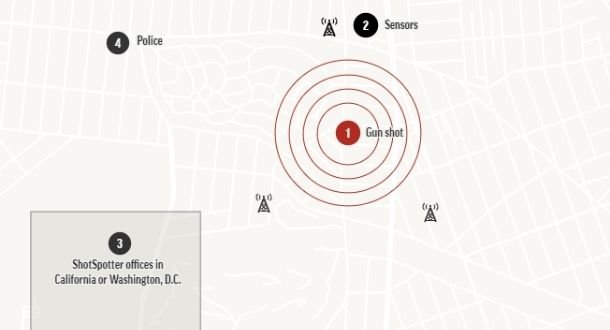Michael Williams, 65, was held in Cook County jail, Illinois after being found guilty of the murder of a young man from his neighborhood who asked him for a ride following an incident of police brutality. Something peculiar during Williams’ trial was the evidence presented by the prosecution, which rather than relying on testimony from family members or informants came from footage taken from a security camera.

In this short video, Williams’ car could be seen passing through an intersection, followed by a loud sound captured by a network of surveillance microphones. Using artificial intelligence, prosecutors analyzed the noise captured by these microphones, determining that this was the sound of the gunshot with which Williams allegedly killed his victim.
Williams’ entire trial was based on conclusions drawn from the ShotSpotter system, a microphone network specifically designed to detect the use of firearms through “sensors, algorithms and artificial intelligence” and employed by multiple law enforcement agencies in more than 100 cities. Since its implementation, U.S. authorities have admitted evidence obtained with ShotSpotter for the investigation of more than 200 criminal cases, which has placed this company as one of the main contractors in security matters.

The night of the incident, Williams and his wife were resting in their home after a day like any other. Williams later headed to buy cigarettes at a gas station, as stores in his neighborhood had been looted after protests over the murder of George Floyd, spread all along the U.S. territory.

Finding the gas station in ruins, Williams made his way back home. As he moved forward he met Safarian Herring, a 25-year-old who lived in his neighborhood and asked him for a ride in his car. In his testimony, Williams mentions that a few meters later a car was paired with his own and, from the passenger seat, an individual fired at his car, directly hitting the young Herring. Although Williams took the victim to the emergency room, Herring was pronounced dead shortly after.
A couple of months after the incident, police showed up at Williams’ home for questioning at the station, where they held him in a cell and told him he was the prime suspect and should face a charge of first-degree murder, even though there was no motive or evidence found in Williams’ car.
While authorities rely on this technology, its use in practice has demonstrated severe flaws and shortcomings, which could reframe the way criminal evidence taken with this technology is analyzed. This is demonstrated by a report published by the Associated Press, based on the analysis of thousands of internal documents and evaluations of the operation of ShotSpotter.
Finally, last month a judge dismissed the case against him for the absence of decisive evidence, so after a year in prison Williams was released. In an interview, Williams expressed frustration at what he considers scant evidence: “I still don’t understand how they were able to use this technology against me. I think it’s unfair.”
To learn more about information security risks, malware variants, vulnerabilities and information technologies, feel free to access the International Institute of Cyber Security (IICS) websites.
He is a cyber security and malware researcher. He studied Computer Science and started working as a cyber security analyst in 2006. He is actively working as an cyber security investigator. He also worked for different security companies. His everyday job includes researching about new cyber security incidents. Also he has deep level of knowledge in enterprise security implementation.
